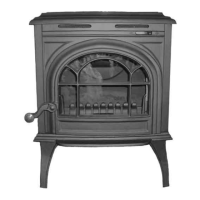13
4. Will following the above-listed steps for starting a re mean perfect results every time?
The quick answer is ‘ most of the time’. There are many variables that may affect your success when starting a
re. Most of those variables and how to deal with them will be learned through experience. Your ability to start a
good re will signicantly increase with time and patience. Some of the reasons for poor stove performance will be
covered in the next section of these instructions.
5. Why can’t I get the re lit?
Damp or wet wood and poor draft are the main reasons for poor results in starting a re. Always use dry, seasoned
wood for your re. Even wood dried for two years will be difcult to ignite if it has become wet.
6. Is it normal for soot to cover the glass at the beginning of a re?
Your stove has been built with an air-wash system that will help keep the glass clear when the rebox has reached
a good operating temperature and has a good draft. Cold rebox temperature and poor draft cause sooting of the
glass. Once the rebox temperature and the draft increase, the soot will burn off.
7. What is draft?
Draft is the ability of the chimney to exhaust or draw smoke produced during the normal combustion process. Too
much draft may cause excessive temperatures in the appliance and may damage the appliance*. Inadequate draft
may cause backpufng or "plugging" of the chimney. There is a certain amount of draft that is required to allow for
your stove to function at its’ highest efciency. A water column gauge can be used to reference this amount.
8. What can cause a poor draft?
The most common factors for poor draft are:
a) Air supply
b) Environmental conditions
c) Cold chimney temperature
d) Poor chimney installation and maintenance
e) Atmospheric pressure
a) Air supply –
Inside the home, normal household appliances such as clothes dryers and forced-air furnaces compete for air,
resulting in air starvation to the re. This creates a condition in the house known as negative pressure. When a
house experiences negative pressure, the combustion gases can be drawn from the chimney and into the house.
This condition is commonly referred to as down-drafting. Increased amounts of insulation, vinyl windows, extra
caulking in various places and door seals can all keep heat in but may also make a home too airtight. An easy
way to stop negative pressure in a home is to crack a window in the room containing the stove.
b) Environmental Conditions -
High trees, low-lying house location such as in a valley, tall buildings or structures surrounding your house and
windy conditions can cause poor draft or down-drafting.
c) Cold Chimney Temperature -
Avoid cold chimney temperatures by burning a hot re for the rst fteen to forty minutes, being careful not to
over-re the stove. If any part of the chimney or parts of the stove start to glow, you are over-ring the stove.
Where possible, install a temperature gauge on the chimney so temperature drops can be seen.
d) Chimney Installation and Maintenance -
Avoid using too many elbows or long horizontal runs or height of your chimney. If in doubt, contact a chimney
expert and/or chimney manufacturer for help. Clean chimney, rain caps and especially spark arrestor regularly,
to prevent creosote build-up, which will signicantly reduce chimney draw and possibly a chimney re.

